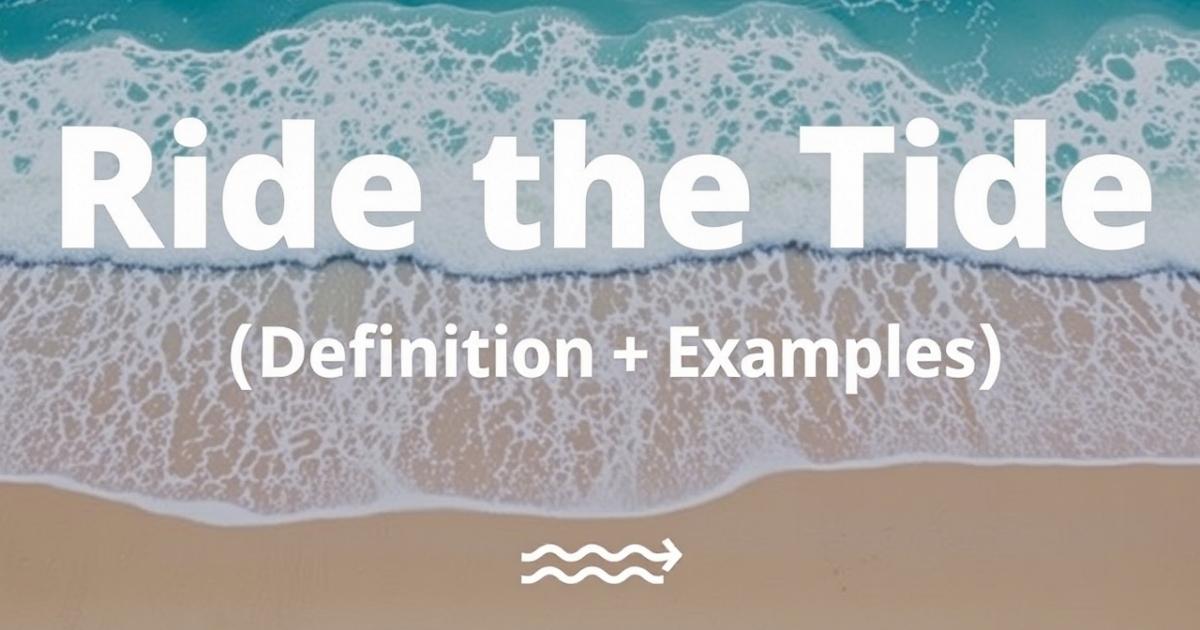Ride the Tide, three simple words that hold the secret to resilience. Life doesn’t wait, and neither should you. Ride the Tide meaning is all about embracing change, adjusting to challenges, and finding your balance. Think of a surfer, waves crash, the ocean roars, but they don’t resist. They ride the wave meaning staying steady, adapting, and moving forward. Life works the same way. Struggles come and go, but fighting them only makes things harder. Instead, learn to ride the tide and flow with confidence.
When storms hit, don’t sink, surf. Stay strong, adjust your footing, and ride the tide toward success. Challenges won’t last forever, but your ability to adapt will. Understanding ride the tide helps you stay patient and make smart choices. In work, relationships, and life itself, the key is simple, stay flexible, stay strong, and let the tide carry you forward.
Understanding Tides
Tides are the natural rise and fall of ocean water caused by the gravitational pull of the moon and the sun. They follow a predictable cycle, with high and low points occurring daily. Coastal areas experience different tidal patterns depending on their location and the alignment of celestial bodies. These movements influence marine life, navigation, and even human activities like fishing and coastal development. Understanding how they work helps in planning activities and avoiding risks associated with strong water currents.
Tides also play a key role in shaping coastlines over time. They affect erosion, sediment movement, and the distribution of nutrients in the ocean. Some places experience extreme variations, while others see minimal changes. The timing and intensity of these movements impact everything from shipping schedules to wildlife behavior. By studying these patterns, scientists and coastal communities can better prepare for environmental changes and make informed decisions for conservation and safety.
Literal Interpretation of “Ride the Tide”
The literal meaning of “Ride the Tide” refers to moving with the ocean’s natural currents. Surfers, sailors, and swimmers rely on tides to navigate safely. Understanding how tides work is essential for water activities, fishing, and coastal safety. The movement of water affects travel, marine life, and beach conditions, making tidal awareness crucial.
- Surfing and Swimming: Surfers wait for the right tide to catch waves, using water flow for better balance and speed. Swimmers must be cautious of changing tides, as strong currents can pull them away from shore. Learning how tides work helps water enthusiasts stay safe and make the most of ocean conditions.
- Boating and Sailing: Tides affect navigation, influencing when boats can enter or leave harbors. Sailors plan trips based on water levels to avoid running aground. Rising tides help vessels move smoothly, while low tides expose hazards. Understanding tidal patterns is essential for safe and efficient travel on the water.
- Fishing and Marine Life: Many fish species move with the tides, making tidal knowledge crucial for fishermen. High tides bring fish closer to shore, while low tides reveal hidden areas where marine creatures gather. Tides also impact breeding and feeding habits, affecting ecosystems and fishing success in coastal waters.
- Coastal Safety and Navigation: Strong tidal currents can create dangerous conditions for swimmers, divers, and boaters. Lifeguards and rescue teams monitor tides to prevent accidents. Coastal areas prone to extreme tidal shifts require careful planning to avoid getting stranded or caught in strong water movements. Tidal awareness ensures safety and preparedness in ocean environments.
Examples of Riding the Tide
- Surfers Catching Waves: Surfers wait for the right tide to get the best waves. They adjust their timing and positioning to ride the ocean’s movement smoothly. Understanding tidal patterns helps them maximize their performance while avoiding dangerous currents or weak waves that won’t carry them far.
- Sailors Navigating Waters: Sailors use tides to their advantage when planning routes. Rising tides help them enter harbors safely, while falling tides can speed up travel in certain directions. They adjust their sailing techniques based on water levels to ensure smooth journeys and avoid getting stranded in shallow areas.
- Fishermen Timing Their Catch: Fishermen follow tidal movements because fish activity changes with the tide. High tides bring fish closer to shore, making it easier to catch them. During low tides, they target exposed areas where fish hide. Understanding the tide improves fishing success and helps conserve energy.
- Businesses Adapting to Market Trends: Just like the ocean’s tides, markets rise and fall. Smart businesses adjust their strategies based on economic conditions. They invest during strong financial periods and conserve resources during downturns. This approach helps them stay competitive and avoid unnecessary risks in fluctuating economic environments.
- People Handling Life Changes: In life, unexpected events happen, job changes, financial struggles, or personal challenges. Instead of resisting, people who “ride the tide” adapt to new situations with a positive mindset. They stay flexible, make the best of circumstances, and move forward, trusting that tough times will eventually pass.
Practical Implications

Practical Implications of Riding the Tide
Handling career changes requires flexibility. Industries evolve, and job roles shift due to technology and market demands. Those who embrace change by learning new skills and adjusting to workplace transformations stay ahead. Instead of resisting change, adapting to new opportunities allows professionals to grow. Riding the tide in a career ensures long-term success in an unpredictable job market.
Financial uncertainty is inevitable. Interest rates, mortgage rates, and market trends fluctuate, affecting personal and business finances. Those who adapt by managing expenses, making smart investments, and staying informed can navigate financial challenges. Riding the tide financially means adjusting to changes wisely, planning for the future, and maintaining stability despite economic fluctuations.
Relationships and social dynamics constantly shift. Friendships, family bonds, and workplace interactions evolve over time. People who ride the tide in relationships accept changes, communicate effectively, and adjust to new situations. Adaptability strengthens connections, ensuring relationships remain meaningful even as circumstances change.
Mental well-being improves when people embrace uncertainty. Life’s challenges can feel overwhelming, but those who stay positive and adaptable build resilience. Accepting life’s ups and downs with a growth mindset reduces stress. Riding the tide mentally means staying calm, focusing on solutions, and maintaining emotional balance through tough times.
Businesses thrive when they adapt to innovation and market shifts. Consumer demand, technology, and competition evolve quickly. Companies that embrace change, update strategies, and invest in new solutions stay ahead. Those who ride the tide in business remain competitive, ensuring growth and success in an unpredictable economic landscape.
Literal meaning
The literal meaning of “ride the tide” refers to moving along with the natural flow of water. Just as the ocean’s tide rises and falls, a person riding the tide moves effortlessly with its current. It symbolizes going along with nature’s movement rather than resisting the powerful force of the sea.
Ride (Verb)
“Ride” means to move along on something, like a bicycle, horse, or wave. It involves balance, control, and adapting to movement. People ride vehicles, animals, or even emotions. The verb suggests being carried by a force, whether physical or metaphorical, and adjusting to its direction smoothly.
Examples of “Ride”
- She loves to ride her bicycle through the park every morning.
- The cowboy learned to ride a horse at a young age.
- He decided to ride the roller coaster despite his fear.
- Surfers ride the waves skillfully along the beach.
- They ride the bus to work every day.
- The politician hoped to ride the wave of public support.
- Investors often ride market trends to maximize profits.
- She tried to ride out the storm by staying indoors.
Tide (Noun)
“Tide” refers to the natural rise and fall of ocean water caused by the moon’s gravity. It also symbolizes changing conditions or trends in life. The tide can bring opportunities or challenges, influencing situations beyond human control. Understanding tides helps in navigation, fishing, and predicting weather changes.
Examples of “Tide”
- The fisherman checked the tide before heading out to sea.
- The high tide covered most of the beach by noon.
- Low tide revealed hidden shells along the shore.
- Economic conditions change like the tide, rising and falling unpredictably.
- The sailor waited for the right tide to set sail.
- The city built barriers to protect against storm tides.
- Emotions come and go, just like the tide.
- Political support often shifts with the tide of public opinion.
Idiomatic meaning
Ride the Tide (Idiom)
“Ride the tide” means adapting to changes and going with the flow instead of resisting. It emphasizes resilience and flexibility in handling life’s ups and downs. Just like ocean tides, challenges come and go, and adjusting helps navigate uncertain situations smoothly.
Examples of “Ride the Tide”
- During financial uncertainty, successful businesses ride the tide of market trends.
- Instead of stressing about job changes, she chose to ride the tide and stay positive.
- Athletes must ride the tide of game momentum to maintain strong performance.
Grammatical points
The phrase “ride the tide” follows a verb-noun structure, where “ride” is an action (verb) and “tide” is the object (noun). This construction makes it an idiomatic expression, meaning it conveys a figurative idea rather than a literal action. “Ride” suggests movement or adaptation, while “tide” represents changing conditions or external forces.
Since “ride the tide” is an idiom, it functions as a complete phrase within a sentence. It can be modified by tenses, such as “rode the tide” (past) or “riding the tide” (present participle). This phrase often appears in motivational or economic contexts, emphasizing flexibility and resilience. It is commonly used without additional modifiers, maintaining its direct and impactful meaning.
Structure and Usage
Basic Structure
The phrase “ride the tide” follows a simple verb + noun structure. “Ride” acts as the verb, meaning to move with or adapt to something, while “tide” is the noun, symbolizing changing situations. This structure makes it easy to use in different contexts, whether literal or figurative.
Example Structure
- Subject + ride the tide + additional detail
- She chose to ride the tide during financial uncertainty.
- Subject + is/was + riding the tide + condition
- He is riding the tide of market trends to grow his business.
- Past tense usage
- They successfully rode the tide of economic fluctuations last year.
Importance of the Preposition “Of”

The preposition “of” plays a crucial role in linking words and showing relationships between them. It indicates possession, origin, or association. In phrases like “ride the tide of change”, “of” connects “tide” to what it represents, making the meaning clearer. Without it, the sentence may feel incomplete or lose context.
Using “of” correctly helps maintain proper sentence structure and meaning. It is essential in idiomatic expressions, ensuring clarity and grammatical correctness. Whether in formal writing or everyday speech, this small word significantly impacts how ideas are conveyed.
Examples of Usage
Figurative Meaning
- The entrepreneur rode the tide of consumer demand to expand his business globally.
- She rode the tide of social change to advocate for equal rights.
- The startup rode the tide of innovation to disrupt the industry.
- He rode the tide of economic fluctuations to make smart investments.
- The athlete rode the tide of game momentum to secure victory.
- The politician rode the tide of public sentiment to win the election.
Related Guide:
60 Double Consonant Words You Must Know In English [2025]
Sample Sentences and Sources
The phrase “ride the tide” is commonly used in both business and everyday language. For example, “Investors must ride the tide of market trends to maximize profits.” This expression highlights the importance of adaptability. Similarly, “She rode the tide of changing fashion trends to grow her brand.” This showcases how individuals adjust to evolving circumstances for success.
Sources like Forbes, The Economist, and Bloomberg frequently use this phrase in financial contexts. News outlets such as The New York Times and The Guardian also reference it in discussions about politics and social adaptation. Whether in media or casual conversations, “ride the tide” remains a powerful idiom for embracing change.
Figurative Use
- Business Growth – Companies ride the tide of market trends to stay competitive and expand their reach.
- Economic Changes – Investors ride the tide of financial uncertainty to make strategic decisions.
- Technological Advancements – Startups ride the tide of innovation to introduce groundbreaking products.
- Political Movements – Leaders ride the tide of public sentiment to gain support and influence policy.
- Career Success – Professionals ride the tide of industry demand to advance in their fields.
- Sports Performance – Athletes ride the tide of game momentum to secure victory.
- Social Change – Activists ride the tide of shifting societal values to advocate for progress.
- Cryptocurrency Market – Traders ride the tide of digital currency fluctuations to maximize profits.
Businesses that adjust to economic fluctuations succeed in the long run. By adapting to market trends and consumer demand, they grow despite uncertainties. Companies that embrace change instead of resisting it are more likely to thrive. Strategic planning and innovation help them stay ahead of the competition.
Athletes must adapt to shifting game momentum to perform well. Staying flexible and adjusting strategies during a match increases the chances of victory. Those who navigate challenges effectively can turn setbacks into opportunities. Success in sports often depends on resilience, quick thinking, and the ability to adjust to changing circumstances.
Political parties evolve with policy adaptation and public sentiment. Leaders who understand social change can guide their supporters effectively. Instead of resisting new ideas, they shape their strategies to meet the demands of the people. Resilience and flexibility in politics help in building long-term influence.
Personal development requires a growth mindset and adaptability. People who embrace uncertainty find new paths to success. Life presents unexpected challenges, but those who remain flexible and open to change can overcome them. Staying positive and learning from experiences leads to long-term progress in both personal and professional life.
Sample sentences
After the startup launched its first product, investors quickly showed interest, allowing the company to ride the financial tide of the booming tech industry.
TechCrunch
The fashion brand adapted to changing consumer demand, riding the tide of social media trends to boost sales and expand its global presence.
Forbes
During the economic downturn, small businesses struggled, but those that embraced digital transformation managed to ride the tide and stay afloat.
The New York Times
Many politicians shift their stance to ride the tide of public sentiment, ensuring they remain in favor as social values evolve.
The Washington Post
Streaming platforms continue to ride the tide of digital entertainment, capitalizing on changing viewer habits and the decline of traditional television.
BBC
The cryptocurrency market surged in popularity, with investors eager to ride the tide of rapid gains despite financial uncertainty and economic fluctuations.
Bloomberg
Sports teams adjust their strategies mid-game to ride the tide of shifting momentum, increasing their chances of securing a victory.
ESPN
Authors often ride the tide of literary trends, shaping their works to match current reader preferences and maximize their book sales.
The Guardian
Major corporations ride the tide of technological advancements by integrating AI and automation into their operations to improve efficiency.
Wired
Entrepreneurs who recognize market trends early can ride the tide of emerging industries, gaining a competitive edge and securing long-term business growth.
CNBC
35 points about using Ride the Tide

- Stay flexible in uncertain times by adapting to changing circumstances and making smart decisions.
- Embrace challenges as opportunities for personal growth and learning through new experiences.
- Keep a positive mindset even when faced with obstacles and unexpected life changes.
- Learn to adjust plans based on evolving market trends and business environments.
- Trust your instincts when navigating financial uncertainty and investment opportunities.
- Accept that setbacks are temporary and part of the journey toward long-term success.
- Adjust strategies based on consumer demand and shifting economic conditions.
- Develop resilience by facing difficulties with patience and determination.
- Use market fluctuations to make strategic investments and financial decisions.
- Adapt to social changes by staying informed and aware of current events.
- Improve problem-solving skills by responding effectively to unexpected challenges.
- Recognize when to push forward and when to step back in uncertain situations.
- Stay open to learning new skills that align with evolving career opportunities.
- Approach setbacks as learning experiences that build strength and perseverance.
- Make informed choices by analyzing past trends and predicting future changes.
- Strengthen relationships by adjusting to changes in personal and professional dynamics.
- Accept that change is inevitable and necessary for growth and improvement.
- Stay proactive rather than reactive when faced with sudden shifts in circumstances.
- Be patient and trust that difficulties will pass with time and effort.
- Keep moving forward even when progress seems slow or uncertain.
- Recognize patterns in history and use them to anticipate future developments.
- Stay calm and collected when facing unexpected life transitions or career shifts.
- Learn to balance persistence with flexibility in achieving long-term goals.
- Take calculated risks by assessing opportunities and potential outcomes.
- Maintain confidence in your abilities even when facing uncertainty or doubt.
- Stay motivated by focusing on long-term success rather than temporary setbacks.
- Adjust expectations based on current circumstances and available resources.
- Use challenges as motivation to innovate and improve your approach.
- Stay prepared for sudden changes by maintaining an adaptable mindset.
- Trust that patience and effort will lead to rewarding results over time.
- Build emotional resilience by accepting ups and downs as part of life.
- Navigate professional challenges by staying flexible and open to change.
- Keep an open mind when encountering new opportunities or unexpected challenges.
- Develop long-term strategies that account for economic and industry fluctuations.
- Focus on progress rather than perfection when adjusting to new situations.
More quotes including “ride the tide”
- “In times of financial uncertainty, wise investors know how to ride the tide of market fluctuations to secure long-term gains.”
- “She learned to ride the tide of public sentiment, shaping her speeches to match the mood of the people.”
- “Successful businesses must ride the tide of technological change, constantly innovating to stay ahead of the competition.”
- “Rather than resisting change, he chose to ride the tide, adapting to new policies with ease.”
- “Athletes must ride the tide of game momentum, adjusting their strategy to seize victory.”
- “The company managed to ride the tide of consumer demand, launching a product just when the market was ready.”
- “Writers and artists often ride the tide of cultural trends, producing works that resonate with the times.”
- “Despite the political shifts, he was able to ride the tide and maintain his influence.”
- “She had no choice but to ride the tide of economic uncertainty, adjusting her spending accordingly.”
- “Entrepreneurs who ride the tide of innovation are the ones who redefine entire industries.”
- “The media giant knew how to ride the tide of public curiosity, turning every controversy into a headline.”
- “He wasn’t leading the movement; he was simply trying to ride the tide of its success.”
- “Learning to ride the tide of social change is essential for those in leadership positions.”
- “By embracing change, she was able to ride the tide of career opportunities instead of being left behind.”
- “In an unpredictable industry, musicians must ride the tide of trends without losing their unique sound.”
- “Startups that can ride the tide of shifting market trends are more likely to survive and thrive.”
- “Rather than resisting, he chose to ride the tide, understanding that adaptation was the key to success.”
- “During uncertain times, it’s best to ride the tide instead of fighting against the inevitable.”
- “Governments must learn to ride the tide of economic shifts, creating policies that benefit the majority.”
- “She decided to ride the tide of public interest, using her platform to raise awareness on important issues.”
FAQ’s
What does it mean to ride the tide?
Ride the Tide means adapting to changes and challenges instead of resisting them. It’s about staying strong, adjusting, and moving forward in life.
What does ride against the tide mean?
Riding against the tide means resisting change or going against the majority. Unlike Ride the Tide, it often leads to struggles and difficulties.
What is the idiom about the tide?
The idiom Ride the Tide refers to accepting life’s changes, adjusting smoothly, and making the best of shifting circumstances without unnecessary struggle.
Is ride the wave an idiom?
Yes, ride the wave is an idiom similar to Ride the Tide. It means taking advantage of opportunities and going with the flow of life.
What is riding the wave?
Riding the wave means embracing momentum and opportunities, much like Ride the Tide, where you move forward without resisting life’s natural changes.
Conclusion
Life is always changing. The best way to handle it is to ride the tide. Don’t fight against challenges, move with them. Ride the tide meaning is simple. It means staying strong, adapting, and making the best of every situation. Just like surfers ride the wave meaning balancing on water, you must find balance in life. Hard times will come, but they won’t last forever. If you ride the tide, you can stay steady and move forward.
Success belongs to those who don’t give up. When things get tough, take a deep breath and ride the tide. Stay calm, adjust, and keep going. Ride the tide meaning teaches patience and courage. The ocean never stops, and neither should you. Life will always have ups and downs. But if you learn to ride the wave meaning, nothing can hold you back. Keep pushing forward, and the tide will lead you to success.

Zion Blaze is a dedicated administrator with 5 years of experience in managing operations, optimizing workflows, and ensuring efficiency. Skilled in leadership, problem-solving, and team coordination.

